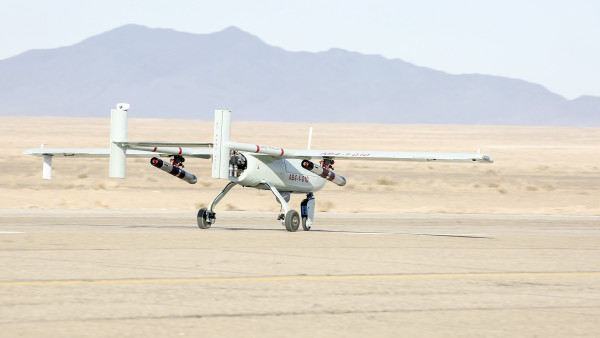In the space of a few short years, Iran has supplied its militia proxies across the Middle East with unprecedented drone capabilities, significantly upping the stakes for its regional adversaries.
Iran’s proliferation of drones in the arsenals of its proxy militias across the Middle East has received quite a bit of attention in recent weeks.
This isn’t surprising. After all, in the space of just a few short years, Tehran has supplied its proxies with an unprecedented number of armed unmanned aerial vehicles (UAVs).
It has also given these groups the means to locally manufacture them, something that could reshape the way wars and proxy conflicts are fought in the Middle East in the near future.
On 12 September, Israeli Defence Minister Benny Gantz said that Iran is using its Kashan airbase north of its cultural capital Isfahan to train “terror operatives from Yemen, Iraq, Syria and Lebanon in flying Iranian-made UAVs”.
“In the space of just a few short years, Tehran has supplied its proxies with an unprecedented number of armed unmanned aerial vehicles”
Shortly thereafter, in his address to the United Nations Generally Assembly on 27 September, Israel’s new Prime Minister Naftali Bennett said that Iran in the past year has “operationalised a new deadly terror unit – swarms of killer UAVs armed with lethal weapons that can attack any place any time”.
“They plan to blanket the skies of the Middle East with this lethal force,” he added, going on to cite Iran’s use of so-called “Shahed 136 drones to attack Saudi Arabia and U.S. targets in Iraq.”
“Iran plans to arm its proxies in Yemen, Iraq, Syria and Lebanon with hundreds and then thousands of these deadly drones,” he said.
Then the militant People’s Mujahideen of Iran (MEK) Iranian opposition group joined this chorus of warnings. In early October, the political wing of the group, the National Council of Resistance of Iran (NCRI), said that the extraterritorial unit of Iran’s Islamic Revolutionary Guards Corp (IRGC), the Quds Force, is using drones for carrying out airstrikes and arming its various proxy groups.
While Israel, and certainly the MEK, always have a strong self-interest in portraying Iran as a dangerous aggressor, Tehran has undoubtedly made unprecedented steps when it comes to supplying many of its powerful militia groups across the Middle East with increasingly independent drone capacities in recent years. There is ample evidence and examples from the past two years alone that aptly demonstrate how this has become the case. The group also said that Iran is building drone components in eight factories across the country that it then ships for assembly and deployment in Iraq and Syria – where it has numerous militia groups operating under its command or at the very least strongly influences.
Reuters, citing Iraqi security officials, reported that no fewer than 250 Iraqi proxy militiamen “had travelled to Lebanon over several months in 2020, where advisors from Iran’s IRGC and Lebanon’s Hezbollah militant group trained them to fly drones, fire rockets, plant bombs and publicise attacks on social media”.
The Reuters story detailed how Iran has shifted its strategy to relying more on smaller groups rather than larger established militias for certain operations. These groups, the report revealed, “are less prone to infiltration and could prove more effective in deploying the latest techniques Iran has developed to strike its foes, such as armed drones”.
And in 2021, these proxies repeatedly demonstrated their growing drone strike capabilities.
On 23 January, three drones targeted the royal complex in Saudi Arabia’s capital Riyadh. While this was not necessarily an unusual event in light of the conflict the Saudi kingdom has been mired in with the Iran-backed Houthis in Yemen, who frequently target that kingdom with increasingly accurate and sophisticated drones and ballistic missile strikes, this particular incident was different.
Those drones took off from Iraq. Furthermore, according to an anonymous Iraqi militia official, those particular UAVs had come “in parts from Iran and were assembled in Iraq, and were launched from Iraq”.
Then, on 26 June, the Iran-backed Iraqi Popular Mobilisation Forces (PMF) paramilitaries displayed some of their UAVs during a parade to mark the seventh anniversary of their founding at Camp Ashraf in Iraq’ Anbar province – which was, incidentally, the main MEK base in Iraq during the years the group was hosted by Iraqi dictator Saddam Hussein. Photos and videos of that event gave some insight into the militia’s growing drone arsenal.
An analysis by Janes defence journal noted that drones on display included the Mohajer-6, one of Iran’s newest drones. Another type of drone on display resembled one of Iran’s Samad series, very similar to drones used by the Houthis against Saudi Arabia. Two other drones on display “did not match a known model but looked like a cross between Iran’s Ababil-3 and Karman 12” drones.
It seems Iran often supply its proxies with hitherto unknown variants of its existing drones, likely devised to give Tehran some degree of plausible deniability when it comes to arming these various groups. In January, for example, Newsweek reported that Iran had armed the Houthis with the so-called Shahed-136 loitering munitions (also known as “suicide” or “kamikaze” drones), a version of the Shahed that was unheard of until that point in time.
The Houthis frequently use Qasef-1 and Qasef-2K loitering munitions in their war with Saudi Arabia. These drones are clearly based on Iran’s well-known Ababil-2 but are, from available evidence, only operated by the Houthis.
That is likely the same case with the drones that have been showing up in the Iraqi militia arsenals.
Since April, these groups have also begun targeting the US troop base in Erbil International Airport, Iraqi Kurdistan, with drones for the very first time. In that first attack in April, the explosive-laden drone followed a civilian flight path to its target at the airport, a hitherto undisclosed CIA hangar.
“Iran also given its proxies the means to locally manufacture drones, something that could reshape the way wars and proxy conflicts are fought in the Middle East in the near future”
Wreckage from that UAV strongly indicates it was assembled in Iran or was at least of Iranian design, like all the other drones.
While Hezbollah in Lebanon is known to have had a drone capacity for some years now, Iran has also begun training its proxies in Syria on how to operate drones. In early October, the Syrian Observatory for Human Rights war monitor reported that the IRGC had started training courses for local militias on how to operate drones.
And of course, Iran has demonstrated over the years that it has developed a formidable arsenal of armed drones that certainly cannot be discounted.
On 14 September 2019, Iran drove this reality home to Saudi Arabia when drones attacked the Saudi Aramco oil-processing facility at Abqaiq in the kingdom’s east. Saudi air defences did nothing to prevent the drones from striking the facility.
It quickly became apparent that the Iranians had used their precision-guided drones to knock out parts of the facility that could be quickly repaired rather than destroy the entire complex, which they were well capable of, and cause a severe economic catastrophe in the kingdom.
Consequently, the attack was clearly a warning shot to demonstrate just how vulnerable Saudi Arabia’s oil infrastructure was, and is, to Iranian attacks. And to add insult to injury, the attack took a mere 17 minutes and cost Iran a paltry $2 million for the weapons it used.
Tehran has given its non-state militia proxies across the Middle East similar capabilities, significantly upping the stakes for its numerous adversaries in that region if war were to break out. It is, therefore, unsurprising that this issue is garnering more and more attention as of late.
By: Paul Iddon
Paul Iddon is a freelance journalist based in Erbil, Iraqi Kurdistan, who writes about Middle East affairs
Follow him on Twitter: @pauliddon
Source: the New Arab
***Show us some LOVE by sharing it!***



